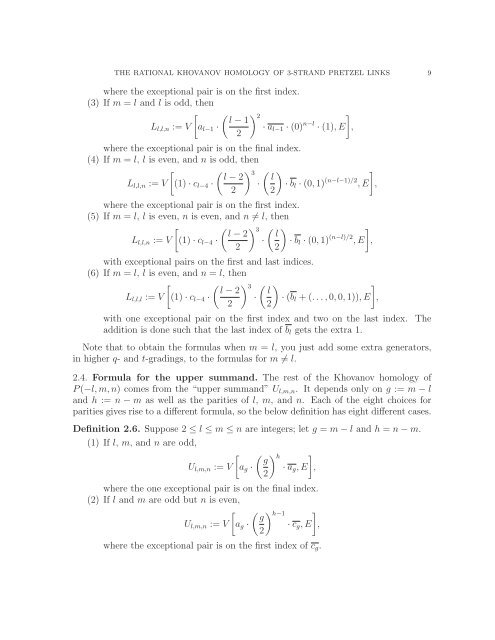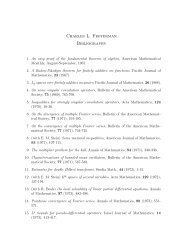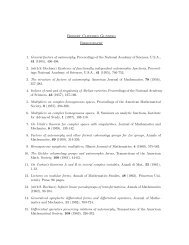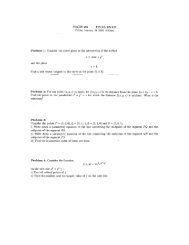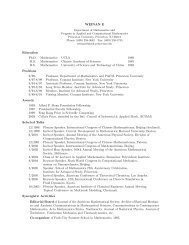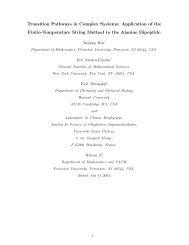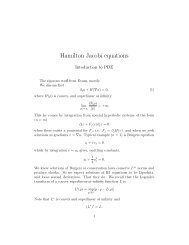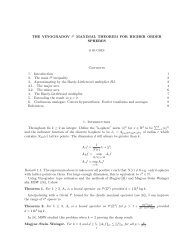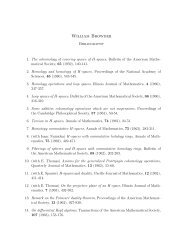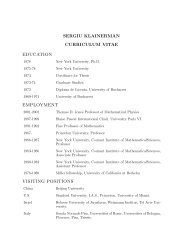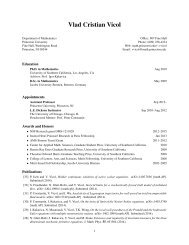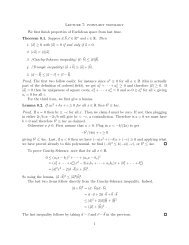The rational Khovanov homology of 3-strand pretzel links
The rational Khovanov homology of 3-strand pretzel links
The rational Khovanov homology of 3-strand pretzel links
Create successful ePaper yourself
Turn your PDF publications into a flip-book with our unique Google optimized e-Paper software.
THE RATIONAL KHOVANOV HOMOLOGY OF 3-STRAND PRETZEL LINKS 9<br />
where the exceptional pair is on the first index.<br />
(3) If m = l and l is odd, then<br />
[ ( ) 2 l − 1<br />
L l,l,n := V a l−1 · · a l−1 · (0) n−l · (1),E]<br />
,<br />
2<br />
where the exceptional pair is on the final index.<br />
(4) If m = l, l is even, and n is odd, then<br />
[ ( ) 3 ( ]<br />
l − 2 l<br />
L l,l,n := V (1) · c l−4 · · · b l · (0, 1)<br />
2 2)<br />
(n−l−1)/2 ,E ,<br />
where the exceptional pair is on the first index.<br />
(5) If m = l, l is even, n is even, and n ≠ l, then<br />
[ ( ) 3 ( ]<br />
l − 2 l<br />
L l,l,n := V (1) · c l−4 · · · b l · (0, 1)<br />
2 2)<br />
(n−l)/2 ,E ,<br />
with exceptional pairs on the first and last indices.<br />
(6) If m = l, l is even, and n = l, then<br />
[ ( ) 3 ( ]<br />
l − 2 l<br />
L l,l,l := V (1) · c l−4 · · · (b l + (...,0, 0, 1)),E ,<br />
2 2)<br />
with one exceptional pair on the first index and two on the last index. <strong>The</strong><br />
addition is done such that the last index <strong>of</strong> b l gets the extra 1.<br />
Note that to obtain the formulas when m = l, you just add some extra generators,<br />
in higher q- and t-gradings, to the formulas for m ≠ l.<br />
2.4. Formula for the upper summand. <strong>The</strong> rest <strong>of</strong> the <strong>Khovanov</strong> <strong>homology</strong> <strong>of</strong><br />
P(−l,m,n) comes from the “upper summand” U l,m,n . It depends only on g := m − l<br />
and h := n − m as well as the parities <strong>of</strong> l, m, and n. Each <strong>of</strong> the eight choices for<br />
parities gives rise to a different formula, so the below definition has eight different cases.<br />
Definition 2.6. Suppose 2 ≤ l ≤ m ≤ n are integers; let g = m − l and h = n − m.<br />
(1) If l, m, and n are odd,<br />
[ ( ) h g<br />
U l,m,n := V a g · · a g ,E]<br />
,<br />
2<br />
where the one exceptional pair is on the final index.<br />
(2) If l and m are odd but n is even,<br />
[ ( ) h−1 g<br />
U l,m,n := V a g · · c g ,E]<br />
,<br />
2<br />
where the exceptional pair is on the first index <strong>of</strong> c g .


